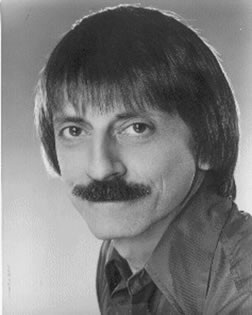Chuck Kelley

Interviewed by Lester Holmes
What inspired you to become a teacher?
Who knew I was going to be a teacher? One person did know that. It was Evelyn McFarland, a teacher that I took lessons from in Willimantic, CT. She became like a second mother. I spent almost all my time in her dance studio. She was the one who pushed and prodded me to make sure that I kept abreast of what was going on in the dance world. At fourteen, she gave me probably the greatest gift that I ever got from a single person. She paid for me to go to NYC to study with, at that time, the four master teachers that taught on Broadway. In addition, she signed me up for Jack Stanley School of Dance. He had a special course that lasted for six days, five classes a day. She gave me money as a Christmas present to pay for classes. I took the classes and it was then that I knew what I wanted to do with my life as a dancer and that I loved the idea of being a teacher. And here I am after all these years of teaching at the age of 78 and that’s exactly how it ended up.
Who was the most influential person in your career?
It has to be Evelyn McFarland. I owe everything to her by her pushing me out of her studio at fourteen to go study in the city. She said if I ever come back, she would never talk to me again. So she gave me the motivation and the opportunity to discover my future was to become a teacher in New York City.
What was the most memorable moment in your career
There are many of them. Probably the most moving was when I was presented with an honorary award from the biggest dance competition and dance teacher organizations at the same time as a celebration and a thank you in recognition for what I had done for dance students for twenty-five years in NYC. To my surprise, the presenters at the event were the first teachers I had studied under in NYC, among them being Paul Draper, Jack Stanley and Johnny Plaza. That is probably the highlight of my first twenty-years of my fifty-five plus years as a NYC dance teacher.
Did you have a most frightening moment in your career?
I had been hired to do the National Tour of “Camelot” because I was a very good acrobat. There was a sequence in the number “Then You May Take Me to the Fair” where I executed a tumbling pass on the diagonal in which i was to end up being caught midair by another dancer. Despite all the rehearsals and the perfect timing pre-performance, when we finally put the move onstage one night, it did not go so well. For some reason the dancer did not catch me and I fell to the floor onto my tailbone. I woke up in the hospital; nothing was broken, but I had to wear a cast for a couple of weeks. I think that probably must have been it.
What experience or legacy would you like to pass on to the next generation?
I would want dancers and dance teachers to know and understand the importance of good dance training and technique. There are many knowledgeable and excellent teachers and choreographers out there. There are also many who should not be teaching. I would rather have one student who is well-trained and technically proficient than a full class of students who learn nothing. Teachers should be dedicated, committed and well-versed in their techniques. Remember that it is not how many tricks one can do. It is more important to be clean, well-trained and technically correct.

What do you think of the state of dance on Broadway and that of theater dance in general today?
In my opinion, there has been a one hundred percent improvement over the past fifty years. My fifty years plus of teaching dance has shown me that a performer can’t just do ‘one thing’ anymore. You can’t be just a singer or only a dancer; you have to do everything. Everywhere you turn nowadays, there are phenomenal and better trained dancers - on Broadway, on television commercials and on television shows. There is also so much more focus on dance today. For so many years, dance always seemed to be overshadowed by everything else; dance was the low priority. Now one must sing, act, dance ballet, tap, jazz and acrobatics…when was the last time you did a backbend and caught your ankles!!
.
|
|
Carolyn Kirsch

Interviewed by James Dybas
What Inspired You To Become A Dancer?
My Cajun grandmother lived in The French Quarter of New Orleans. It was in the days when the barkers would throw open the doors of the strip clubs that lined Bourbon Street to give prospective customers a peek. As a kid, I was transfixed by the music, the colored lights, the sequin gowns, and the overall movement. My mother quickly got me away from Bourbon Street and into ballet class! I never left.
What Teacher Had The Most Influence On Your Career?
Madame Maria Swoboda. She and her husband Vecheslav Swoboda (formerly a soloist with the Bolshoi Ballet) established a ballet school in NYC which was regarded as one of the finest in the country. It was taken over by the Ballet Russe de Monte Carlo as the nucleus of it’s school. And my first ballet teacher, Elvie Demarco, in Pensacola Florida. She would take her promising students to NYC every summer. I was 15 the first year I was chosen to go, and we studied at The Ballet Russe de Monte Carlo School. Over the next couple of summers I was put on scholarship by Madame Swoboda and was slated to join the Company. However, Ballet Russe lost it’s financial footing and ceased to exist. That’s when I started auditioning for musicals.
What was your most memorable dance experience?
There are two, both in Michael Bennett’s choreography: Performing “Tick Tock” in the national tour of “Company” and also that moment in the opening of “A Chorus Line” when the full company turns and faces away from the mirror. It still gives me goose bumps when I think about it. I feel so grateful to have been a part of that original company.
What experience or legacy would you like to pass on the the next generation?
Seek out the best teachers. Look for those masters who nurture and support young talent, avoid those who are demeaning and inspire fear. As your career progresses don’t be afraid to study other disciplines. The artistic process is in constant flux so embrace creativity wherever you find it. Reinvention over a long career can be very exciting. You never know when the muse will tap you on the shoulder
What do you think of Broadway and Theatre dance today ? Has it changed from the time you danced on Broadway?
From what I’m seeing, it appears to have become more athletic, even gymnastic at times. It can be very exciting in the velocity of the movement and the dancers are so strong. They have beautiful, well-rounded technique. But I sometimes miss dance that tells a story. I sit on the Board of Directors of The Connecticut Dance Alliance so I’m around many dance companies. Some of my favorite work is being done by Dance Theatre of Harlem. They’re beautifully trained, work well within this new gymnastically oriented technique, but they have a strong sense of acting intention and conveying the story through movement. As for Broadway, I’m always looking for that breathless moment when The King puts his arm around Anna’s waist.
What was the most frightening moment in your dance career?
In “La Grosse Valise” a few of us had a flying sequence. My wires became entangled and when the cue to fly was given, I went up and slammed into the portal and then half slid, half climbed down. Tangled up in reams of black velvet with my gothic curled hair piece falling off, I had to stand there and wait for another cue to fly. Terrifying! After the show the choreographer (Colette Brosset) came over to me and said in her beautiful French accent “Carl, you veer so beautiful - you smile ze whole time.” Took me awhile to recover from that one.

Carolyn Kirsch performing
"Tick Tock" in COMPANY
When did you decide to move into teaching and directing ?
I moved to Connecticut in the mid 1980’s and found there were fascinating possibilities for work in the area. I joined the faculty of The Greater Hartford Academy of the Arts as well as The Hartford Conserva-tory. I presently chair the Musical Theatre Department of The Center for Creative Youth at Wesleyan, a summer intensive pre-college arts program for high school students. At the same time I was moving into directing productions throughout the area and was thrilled to be presented with an Arts Advocacy Award by the Mayor of Middletown, CT. From having studied at the HB Studio with Uta Hagen and later, Austin Pendleton, my sensibilities had been developed for directing. My years with Michael Bennett and Bob Fosse were invaluable training. Every day I felt as if I was in a Master Class with the absolute best.
Do you have any closing thoughts about your life as a dancer ?
As I’ve aged, I realized that I would never be able to move through space with the freedom and ease I had so enjoyed. As dancers we live our lives wrapped in the arms of beautiful movement. Those arms were being withdrawn from me little by little and I had to remain standing somehow. I felt as if I was now in new territory and I honestly didn’t know how to function without being a dancer first and foremost. That’s why Dancers Over 40 has been so important to me. The organization has reinforced that once a dancer, always a dancer. The importance of what we all have felt, moving through space, is honored.
|





